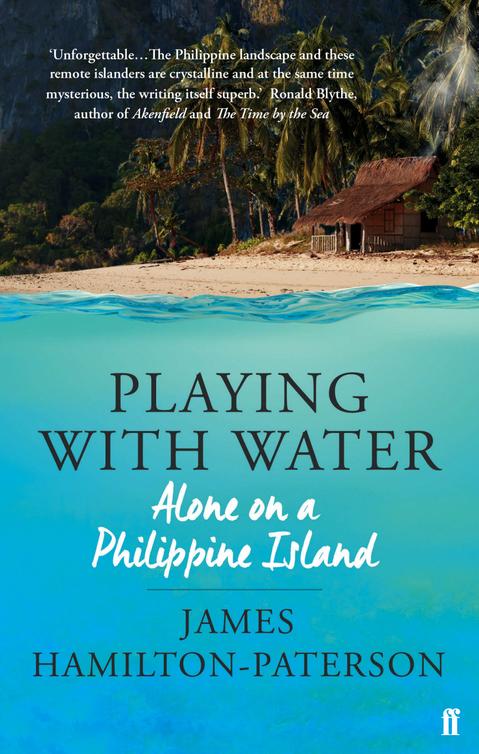Playing with Water
Read Playing with Water Online
Authors: James Hamilton-Paterson



Passion and Solitude
on a Philippine Island
JAMES HAMILTON-PATERSON

for
Jane Stephens
Armour, poison, camouflage and a hidden way of life are very common in reef dwellers. In the labyrinthine world of tunnels and crevices, where soft-bodied and vulnerable creatures hide, specialised carnivores amongst the crustaceans, worms and molluscs roam as well, living their whole adult lives there and continually stalking their prey. This largely concealed world within the reef is an extensive, vital and thriving one.
Charles R. C. Sheppard
A Natural History of the Coral Reef
It is a convention of Western thought to believe all cultures are compelled to explore, that human beings seek new land because their economies drive them onward. Lost in this valid but nevertheless impersonal observation is the notion of a simpler longing, of a human desire for a less complicated life, for fresh intimacy and renewal. These, too, draw us into new landscapes. And desire causes imagination to misconstrue what it finds.
Barry Lopez
Arctic Dreams
I am a man of curious temperament who prefers on most occasions to be dumb. It is a selfish trait in my character which I try to master. Whenever I walk or travel I am generally silent; I like to observe the scenery closely, and sometimes I lose all consciousness of myself in it. The old proverb ‘Two’s company …’ does not hold true in my case; it would be difficult for me to find any second person who could walk with me and would be happy if I did not talk.
Chiang Yee
The Silent Traveller
- Title Page
- Dedication
- Epigraphs
- Preface
- Introduction
-
- Part One
: Tiwarik and Kansulay - Chapter 1
- Chapter 2
- Chapter 3
- Chapter 4
- Chapter 5
- Chapter 6
-
- Part Two:
Manila - Chapter 7
-
- Part Three
: Tiwarik and Kansulay - Chapter 8
- Chapter 9
- Chapter 10
- Chapter 11
- Chapter 12
-
- Glossary
-
- Notes
-
- References
-
- Acknowledgements
- About the Author
- By the Same Author
- Copyright
It is only eleven years since I wrote
Playing with Water,
which concerns living in a Philippine province. Yet when I came to re-read the book the familiar landscape it evoked took on the quality of a dream, or of something pungently recalled from a far-off summer in childhood. This was partly surprising, since I still spend time each year in ‘Kansulay’ where things have scarcely changed. Most of the people I described are still there, doing much the same things, older and no richer. The village’s water problem is worse, the river having finally shrunk to a rivulet. Many people were blaming a copper-mining company that hoarded increasing amounts of water for its own use behind dams in the hills. Then in early 1996 there was an accident at the mine which caused an ecological disaster. The province’s major river system was killed in a matter of days, suffocated beneath millions of tonnes of waste slurry. Although ‘Kansulay’ was not directly affected, being on the outermost fringes of the disaster area, its water problems now feel as though they are no longer curable at local level but have to do with events beyond our control. One could say, therefore, that while ‘Kansulay’ remains largely the same, its prospects have become still more equivocal.
The book’s central section on Manila presents a slightly different case. A decade ago I wondered whether it sounded too jarring a note, interrupting as it does the bucolics of the rest of the book. Now I am glad it is there because today I recognise still more clearly how large that city bulks in the psyche of even the most rural community, representing as it does the myth of escape, the promise of opportunity – all the sad, hopeful centripetalism of the developing world. Manila remains very much the same city as the one I described, although certain things have improved. Today’s capital is not so visibly decadent as it was during the last years of the Marcoses. (One
obvious difference is the recent removal of the child sex industry from public gaze.) Perhaps in those days I was incapable of giving an affectionate portrait of Manila – maybe of any city – but this chapter still reminds me of the end of an era, a phrase that vainly begs one to define exactly what it is that has ended. Today’s traffic and pollution are worse; the T-shirt slogans are less wittily political and now often have a vapid New Age ring to them; there is more money about for the prospering classes; the beginnings of a genuine economic hopefulness are in the air …
Plus c’est la même chose.
The biggest change in any of the book’s landscapes has been to its principal setting, that magic isle ‘Tiwarik’. In brief, ‘Tiwarik’ is no more; it no longer exists. At the beginning of
Chapter 12
I ploddingly gave all the reasons why I thought it could never become a touristic ‘paradise island’ (too small, too remote, too nondescript, completely lacking in fresh water and a stable beach …). I suppose I was trying to convince myself of its immunity, which makes the subsequent ironies particularly mocking: that the one term I omitted from my confident arithmetic was
money
and its power to overcome such minor drawbacks; that even as I wrote the chapter, a Japanese businessman must have been negotiating the island’s purchase. Within a year or two, construction of an exclusive resort had begun. A road was blasted up the cliff and the first vehicles ever to set wheel on ‘Tiwarik’ were grinding up from the little cove, laden with cement and water for the building of a clubhouse, villas, tennis courts, a swimming pool, a miniature golf course. When I returned to ‘Sabay’ to find all this a fait accompli, ‘Tiwarik’ had been banished for good to wherever it is that vanished landscapes go, as if it had never been more than an invention, an act of solipsism. I described the island’s transformation from lump of rock to parcel of real estate in the ‘Islands’ chapter of
Seven-Tenths,
but since then have lacked the courage to go back. I keep in touch with my former friends and diving companions from ‘Sabay’, but only by meeting them on neutral ground in other towns along that coast.
There seems to be no simple rule for dealing briskly with nostalgia. At the very least we note the inevitable passing of places, their very mutability undercutting our fatuous sense that when we first glimpsed them they were in some
way original, unchanged and ‘unspoiled’. To the honeymooning Japanese couples who have spent time on ‘Tiwarik’ in the last eight years, the island is no doubt as pristine in its views and associations as it still is in my memory. Other places I mention in
Chapter 12
(especially Manaos and Labuan) have been similarly transformed. I remember Labuan Island off Sabah as a backwater, sleepy and civil, very like a province in the Philippines, with the endless jungles of Borneo lying just over one watery horizon. In 1992 Labuan was declared an international tax haven, an enterprise zone with a new airport and infrastructure to cater for Southeast Asia’s investment boom, while the jungles over the horizon have since proved neither limitless nor eternal. In its small way, ‘Tiwarik’ is also a part of this pattern.
Since this book was written, then, certain externals of the landscape I depicted have changed. Yet in most other respects so little has altered that there is no need to amend the text. I have therefore left it, with whatever its shortcomings, except to correct some minor errors, punctuation, or the odd typo. The prices I note on p. 89 and pp. 274–5 are now quite definitely out of date, but I decided to leave them, too. The kilogram of rice which in 1985 cost six pesos in ‘Kansulay’ may now cost twenty-four, but the relativity of prices to wages remains largely unchanged and rural poverty has, if anything, worsened slightly. Observing this, the author himself now believes even less than he once did in that sacred cow, Progress, and her hallowed calf, Development. Witnessing the arrival of electricity in ‘Kansulay’ was to see a revolutionary change of living conditions which were assimilated in a figurative afternoon. The speed with which novelties wear off, leaving the sum of contentment stubbornly unincreased, is a reminder (hardly needed in this consumerist heyday) that we are all of us fundamentally unappeasable. The people of ‘Kansulay’, like those of ‘Sabay’, often look back to the recent past when ‘things were better’. They see no necessary irony in those ‘better days’ having been at a time of Martial Law and the Marcoses’ now discredited regime.
James Hamilton-Paterson,
April 1998
In the middle Sixties I lived for a year in Libya during which time I made several friends among the personnel of the huge American air base outside Tripoli, Wheelus Field AFB. Two of these were a couple in their late twenties. He was an engineer from Dayton, a large gentle fellow besotted with fast cars. His wife was a Filipina whom I first met when I stopped to help her change a wheel. From that incident a friendship grew which effectively ended, as such things often do, with the expiry of our respective contracts. One night we were sitting in a car I had bought with her husband’s help, a 1956 Ford Fairlane with tinted windscreen and automatic transmission. We were not far from Base, on the edge of semi-desert across which drifted the scent of orange groves from some Italian’s plantation. She looked up at the silhouette of a date palm and said: ‘We have coconuts at home, not dates. Every day my father makes beer from coconut sap.’
The wistfulness, the ‘we’ told me she was not talking as a naturalised American. The way she spoke hinted at an unknown rurality, a place of great difference whose language I had heard her use to her children but which I knew annoyed her husband because it sounded ‘native’ and excluded him. With that interest which exiles often feel for each other I wanted to see her real homeland, wherever it was her father made coconut beer. While we were talking the F-4 Phantoms were taking off thunderously in pairs, their afterburners and navigation lights floating up over the boundary fence into the soft North African night. They were bound for bombing ranges and training grounds deep in the desert, for they were practising war. The great build-up had come: everyone was going to Vietnam.
Re-Up Now!
was the slogan printed on the inside cover of the book
matches sold on Base. Re-Enlist! Don’t be left out! Don’t miss victory! Think of your career! I owed my Fairlane to this injunction which had been obeyed so briskly by the car’s previous owner he had let me have it for $100 the day before he was posted back to the States.
A few years later I finally made it to South-East Asia myself. I was a journalist, a freelance writer, a drifter. In the grip of that monstrous magic war I visited nearly all the principal countries of the area, certainly those in some way actively drawn into the Vietnam conflict. The notable exception was the Philippines. I knew that President Magsaysay had committed the Philippines to the covert war in Vietnam; I knew that President Marcos had reneged on his own campaign promise and had committed the two thousand-strong Philcag. I knew about the US bases in the Philippines, about fabled Manila and R&R, and I knew about a girl’s father who made coconut beer. Yet I never went there. Always something cropped up.
Ever since then that country has had for me something of an air of unfinished business: unfinished in 1979 when I finally went for the first time and unfinished today in my regular commutings, my residences which now take up more than a third of each year.